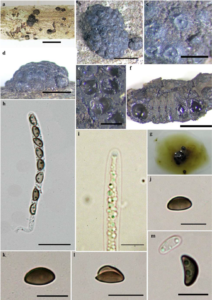Annulohypoxylon thailandicum Daranagama & K.D.Hyde.
Index Fungorum number: IF550799, Facesoffunginumber:FoF00367, Fig. 1
Etymology – refers to the country, Thailand where the new species was collected.
Holotype – MFLU 13-0441
Saprobic on corticated and decorticated wood, Sexual morph: Ascostromata 0.5–0.7 × 0.8–1.7 × 0.8 mm (x̄ = 0.7 × 1.5 × 0.8 mm), effuse-pulvinate, with conspicuous perithecial mounds exposing almost completely, sphaerical, hemisphaerical, surface black, carbonaceous, blackish granules immediately beneath surface and between perithecia, with KOH extractable pigments greenish-olivaceous (90), perithecia 0.35–0.5 × 0.3–0.7 mm (x̄ = 0.4×0.5 mm), immersed, encased in carbonaceous tissue, sphaerical, ostioles coarsely papillate, encircled with a small truncatum–type disk, 0.3–0.45 mm diam., paraphyses not seen. Asci (76.7–)89–100.8(–107) × (4.1–)4.5–6.5(–6.9) μm (x̄ = 97 × 5.6 μm), 8-spored, unitunicate, cylindrical, short-pedicellate, with apical ring faintly bluing at base or not bluing in Melzer’s reagent, globose, 1.5×2μm. Ascospores (5.8–)6–11.5(12) × (3.2–)4–6.5(6.8) μm (x̄ = 12.5 × 5.6 μm), uniseriate, one-celled, ellipsoidal inequilaterally with narrowly rounded ends, brown, with a straight germ slit running full length of the spore, epispore smooth, perispore dehiscent in 10 % KOH. Asexual morph: Undetermined.
Culture characters – Colonies on OA at 25–28 °C reaching 5 cm in 7 days, whitish colonies, azonate with diffuse margins, reverse at first whitish and turning light brown after 3–4 days, developing black pigments after 8–10 days.
Material examined – THAILAND, Chiang Mai, Doi Suthep, on decaying wood, 10 November 2012, D.A. Daranagama and K.D. Hyde AXL 107 (MFLU 13–0441, holotype); ex-type living culture, MFLUCC 13–0118.
GenBank Accession numbers – ITS: KP744434; LSU: KP744476.
Notes – Annulohypoxylon thailandicum, with characters such as brown ascospores with a germ slit originating from one end more or less up to the full length of the spore, greenish olivaceous/dull green KOH extractable pigments, dehiscent perispore in 10 % KOH and ostioles encircled with a small disk, can be compared with A. archeri or A. microcarpum. Both A. archeri and A. microcarpum have ostiolar disks of around 0.2 mm diam., with conspicuous perithecial mounds with reddish tones and sphaerical perithecia. A. microcarpum has rather small perithecia (0.15–0.2 mm diam) and small ascospores (7–8×3–4μm), whereas Annulohypoxylon archei has perithecia of 0.1 mm diam. and ascospores of 9–10.5μm×4–5μm (Ju and Rogers 1996). Therefore, A. archeri could be morphologically the most simialr taxon. However, the new species has a black surface, larger perithecia and wider ostiolar disks as well as smaller ascospores, as compared to A. archeri.

Fig. 1 Annulohypoxylon thailandicum (holotype) a Stromatal habit on wood b Perforations seen from above c Ostioles with ostiolar disks d Stromatal surface in side view e Perithecia from above f Cross section of the stroma showing perithecia g Formation of pigments in KOH h Mature ascus in water i Ascus in Melzer’s reagent showing inconspicuous apical apparatus j, k Ascospores in water l Ascospore with germ slit m Dehiscent perispore in 10 % KOH. Scale bars: a–d=5 mm, e, f=1 mm, h–m=10μm.
